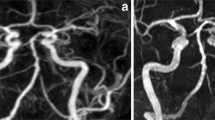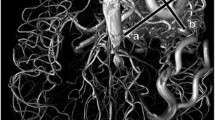Abstract
Purpose
The aim of this study was a comparison of the diagnostic value of time-of-flight magnetic resonance angiography (TOF-MRA) and contrast-enhanced (CE) MRA in the setting of acute stroke MRI. The hypothesis was that CE-MRA has at least the same diagnostic value as the commonly used TOF-MRA.
Materials and Methods
A total of 66 stroke patients underwent MRI up to 24 h after symptom onset and again after 3–6 days. Primary slices and maximum intensity projections (MIP) of both techniques were evaluated separately and in combination by two readers in consensus. The quality of imaging and degree of vascular pathologies were evaluated.
Results
Out of 109 examinations 105 could be evaluated. There were no significant differences in imaging quality in normal vascular segments. For arterial segments distal to an occlusion CE-MRA allowed better visualization of vessels than TOF-MRA. A combined evaluation of both techniques allowed a significantly better assessment than evaluation of images by one technique alone. In contrast to TOF-MRA, CE-MRA included extracranial segments.
Conclusion
CE-MRA and TOF-MRA do not differ regarding the evaluation of normal intracranial vessels. CE-MRA provides the advantage of good visualization of vessels distal to occluded segments. Furthermore CE-MRA allows visualization of extracranial vessels and faster image acquisition. TOF-MRA can be equivalently used if the administration of contrast agents is not possible.
Zusammenfassung
Ziel
Die Standardmethode zur Darstellung der hirnversorgenden Arterien in der Schlaganfallmagnetresonanztomographie ist die „Time-of-flight“-MR-Angiographie (TOF-MRA). Sie hat eine relativ lange Untersuchungszeit bei eingeschränktem Untersuchungsfeld, das nur die intrakraniellen Hirnarterien einschließt. Diese Studie vergleicht die kontrastmittelverstärkte MRA (CE-MRA) und die TOF-MRA bei Patienten, die mit einem Schlaganfall-MRT untersucht worden sind.
Material und Methoden
Innerhalb von 24 h nach Schlaganfall und wiederholt nach 3 bis 6 Tagen wurden 66 Patienten im MRT untersucht. Die Bilder der beiden MRA-Techniken wurden zunächst getrennt, dann in Kombination ausgewertet. Analysiert wurden die Primärschichten und die Maximum-Intensitäts-Projektionen (MIP). Die Qualität der Darstellung und der Zustand einzelner Arteriensegmente wurden von 2 Betrachtern im Konsensus bewertet.
Ergebnisse
Es waren 105 von 109 Untersuchungen auswertbar. Für nichtpathologisch veränderte intrakranielle Arterien bestand für die Qualität der Darstellung kein signifikanter Unterschied. Gefäßsegmente distal eines Verschlusses waren aber in der CE-MRA deutlich besser beurteilbar. Eine kombinierte Auswertung beider Verfahren ergab für alle Segmente eine signifikant bessere Darstellung und Beurteilbarkeit als das jeweilige Einzelverfahren. In der CE-MRA waren bei technisch guten Untersuchungen die extrakraniellen Gefäßsegmente beurteilbar. In der TOF-MRA wurden diese Segmente nicht erfasst.
Schlussfolgerungen
Hinsichtlich der Beurteilbarkeit von nichtpathologisch veränderten intrakraniellen Gefäßen unterscheiden sich CE-MRA und TOF-MRA nicht. Die CE-MRA bietet allerdings den Vorteil, auch Gefäßabschnitte distal von Verschlüssen sowie extrakranielle Gefäße beurteilen zu können. Die Akquisition ist schneller. Wenn eine Applikation von Kontrastmittel nicht möglich ist, stellt die TOF-MRA für die Untersuchung der intrakraniellen Arterien eine gleichwertige Alternative dar.


Similar content being viewed by others
References
Jansen O, Heiland S, Schellinger P. Neuroradiologische Diagnostik beim akuten arteriellen Hirninfarkt. Momentaner Stellenwert neuer Verfahren. Nervenarzt. 1998;69:465–71.
Schellinger PD, Jansen O, Fiebach JB, et al. Feasibility and practicality of MR imaging of stroke in the management of hyperacute cerebral ischemia. AJNR Am J Neuroradiol. 2000;21:1184–9.
Ryu CW, Lee DH, Kim HS, et al. Acquisition of MR perfusion images and contrast-enhanced MR angiography in acute ischaemic stroke patients: which procedure should be done first? Br J Radiol. 2006;79:962–7.
Yang JJ, Hill MD, Morrish WF, et al. Comparison of pre- and postcontrast 3D time-of-flight MR angiography for the evaluation of distal intracranial branch occlusions in acute ischemic stroke. AJNR Am J Neuroradiol. 2002;23:557–67.
Heiserman JE, Drayer BP, Keller PJ, et al. Intracranial vascular stenosis and occlusion: evaluation with three-dimensional time-of-flight MR angiography. Radiology. 1992;185:667–73.
Phan T, Huston J III, Bernstein MA, et al. Contrast-enhanced magnetic resonance angiography of the cervical vessels: experience with 422 patients. Stroke. 2001;32:2282–6.
Stehling MK, Niedermeyer M, Laub G. Kontrastmittelverstärkte Magnetresonanzangiographie. Theorie, Technik und praktische Durchführung. Radiologe. 1997;37:501–7.
Yang CW, Carr JC, Futterer SF, et al. Contrast-enhanced MR angiography of the carotid and vertebrobasilar circulations. AJNR Am J Neuroradiol. 2005;26:2095–101.
Petersen D, Klose U. Indikationen zur Kontrastmittelgabe bei der MR-Angiographie der Hirngefäße. Radiologe. 1997;37:508–14.
Ishimaru H, Ochi M, Morikawa M, et al. Accuracy of pre- and postcontrast 3D time-of-flight MR angiography in patients with acute ischemic stroke: correlation with catheter angiography. AJNR Am J Neuroradiol. 2007;28:923–6.
Pantano P, Toni D, Caramia F, et al. Relationship between vascular enhancement, cerebral hemodynamics, and MR angiography in cases of acute stroke. AJNR Am J Neuroradiol. 2001;22:255–60.
Kollias SS, Binkert CA, Ruesch S, et al. Contrast-enhanced MR angiography of the supra-aortic vessels in 24 seconds: a feasibility study. Neuroradiology. 1999;41:391–400.
Randoux B, Marro B, Koskas F, et al. Carotid artery stenosis: prospective comparison of CT, three-dimensional gadolinium-enhanced MR, and conventional angiography. Radiology. 2001;220:179–85.
Remonda L, Senn P, Barth A, et al. Contrast-enhanced 3D MR angiography of the carotid artery: comparison with conventional digital subtraction angiography. AJNR Am J Neuroradiol. 2002;23:213–9.
U-King-Im J, Trivedi RA, Cross JJ, et al. Measuring carotid stenosis on contrast-enhanced magnetic resonance angiography: diagnostic performance and reproducibility of 3 different methods. Stroke. 2004;35:2083–8.
Saager C, Fitting T, Goebell E, et al. Contrast-enhanced MR angiography improves detection of Carotid-T occlusion by acute stroke MRI. Clin Neuroradiol. 2008;18:163–7.
Conflict of Interest Statement
The authors declare that there is no actual or potential conflict of interest in relation to this article.
Author information
Authors and Affiliations
Corresponding author
Rights and permissions
About this article
Cite this article
Alfke, K., Jensen, U., Pool, C. et al. Contrast-enhanced Magnetic Resonance Angiography in Stroke Diagnostics. Clin Neuroradiol 21, 5–10 (2011). https://doi.org/10.1007/s00062-010-0039-0
Received:
Accepted:
Published:
Issue Date:
DOI: https://doi.org/10.1007/s00062-010-0039-0
Keywords
- Stroke
- Magnetic resonance imaging
- Contrast-enhanced magnetic resonance angiography
- Time-of-flight magnetic resonance angiography




